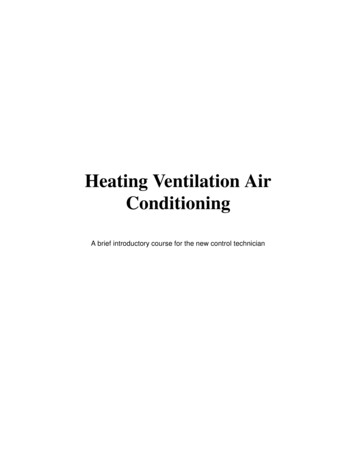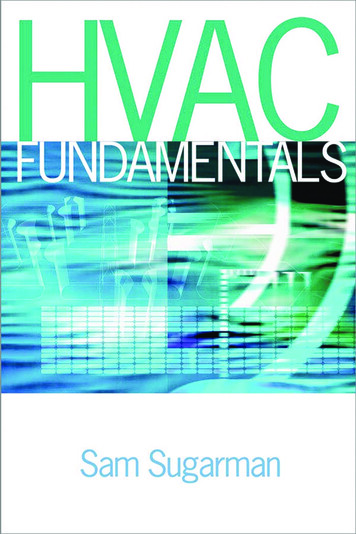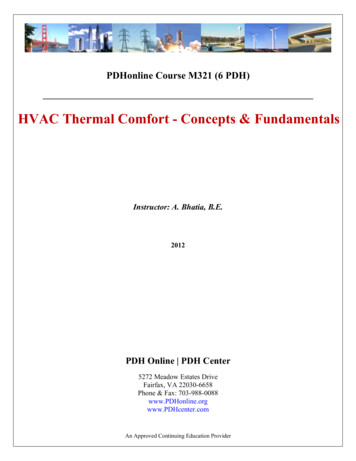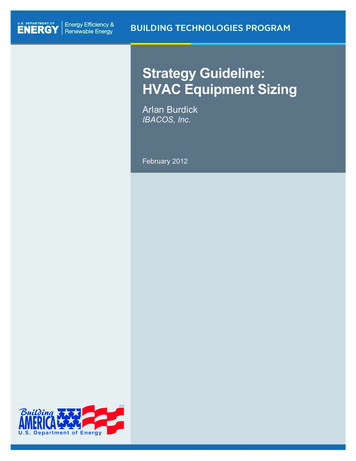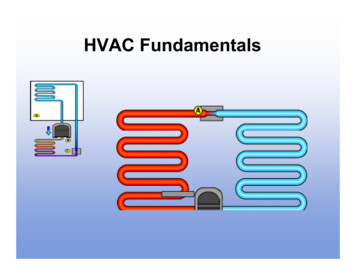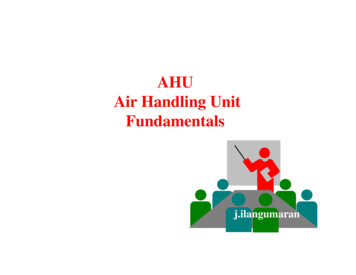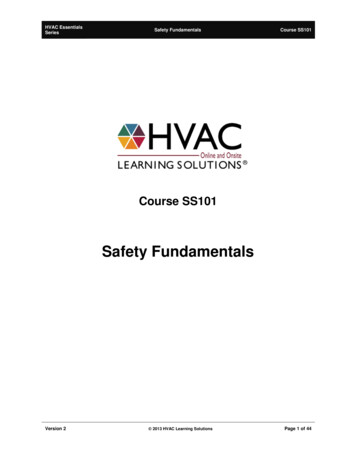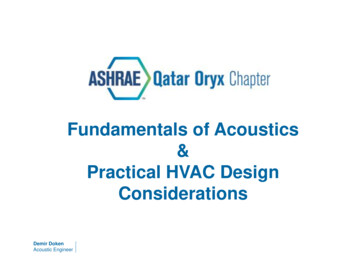
Transcription
Fundamentals of Acoustics&Practical HVAC DesignConsiderationsDemir DokenAcoustic Engineer
What is sound?Sound is a mechanical wave that is an oscillation of pressure transmittedthrough some medium (like air or water), composed of frequencies whichare within the range of hearing.In 20 C (68 F) air at sea level, the speed of sound is approximately 343m/s (1,230 km/h; 767 mph)Propagation of soundSourcemovingmembraneMedium - AirReceiverair particles, transfer of energypressure at receiverto next particlesoscillates with source freq.
What is frequency? The term Frequency applies to periodic events - such assound waves. The time for one event to take place is T. T is measuredin seconds. The Frequency is the number of times the eventhappens per second. The unit of measurement for Frequency is Hertz or Hz. 1 Hz means that the event takes place once per second. 100 Hz means that the event takes place 100 times persecond.T1f T1 Hz s
Frequency range of speech and music
Frequency bands The most common frequency bands have their centers at octave or 1/3octave intervals.Octave Bands631252505001k2k4k8k
Frequency Characteristics of HVAC Eq.
Sound Power & Sound pressure Sound pressure level of everyday noise sources
Sound pressure level Sound pressure level of everyday noise sources
Noise Criteria Curves (NC) One of the most commonly used single-number readings is the Noise Criteria(NC) standard. NC is defined as single number noise rating system commonly used to rate thesteady-state noise levels in a room. They consist of a family of curves whichdefines the maximum allowable sound pressure levels in octave bands.
Types of Sound Transmission Airborne Sound: Airborne sound refers to sources which produce sound bydirectly setting the air around them into vibration. Impact Sound : Impact sound refers to sources which produce sound byimpulsive mechanical excitation of part of a building (e.g. by footsteps, electriclight switches, slamming doors). Many sources of impact sound also producesignificant levels of airborne sound. Structure-borne Sound: Structure-borne sound is often used to refer to soundthat travels for long distances via the structure, especially in connection withvibrating machinery linked directly to the structure
Sound Absorption VS Sound Insulation Sound Insulation: Sound insulation refers to the act of impeding the transmissionof sound from one area to another or from a source to a receiver. Typicalexamples include the sound insulation between adjacent apartment units orbetween a busy highway and one’s bedroom. The best way to improve theinsulation between two areas typically involves the use of heavy materials suchas concrete or gypsum board. Sound Absorption: Sound absorption refers to the phenomenon whereby someor all of the sound energy incident on a surface is either converted into heat orpasses through the absorber.
Noise Paths for HVAC Equipment
HVAC Noise Control Duct VelocitiesAir velocity within a duct system influences the noise levels significantly.Regenerated noise can be created by transition pieces, bends, dampers, grillesand diffusers. Regenerated noise can be avoided by limiting the air velocitieswithin the duct system.NR or NCdesignIn-duct air velocity (m/s)MainBranchFinal 4.0409.07.05.0requirement
HVAC Noise Control Regenerated Noise From Duct Elements
HVAC Noise Control Regenerated Noise From Duct Elements
HVAC Noise Control Sound Breakout from the Ducts Breakout is the sound associated with fan or airflow noise inside a duct thatradiates through duct walls in to the surrounding area.
HVAC Noise Control Silencer positioning for lowregenerated noise and lowpressure dropL 3 to 4 duct diameters Silencers positioning forminimizing breakout noise
HVAC Noise Control Cross-talkWhen two adjacent or closely positioned rooms are sharing the sameductwork, sound travels within ducts and decrease the soundinsulation dramatically.Requirement inAttenuatorNoise reductionreceiver roomLength (mm)at 500 Hz (dB)NR - NC 4075025NR - NC 35100030NR - NC 30125035NR - NC 25150040
Practical Design Recommendations HVAC design for AuditoriumsAdvantagesDisadvantages-Lower cost- Fights natural convection- Underseat noise break in weakness- diffucult to avoid draughts- throw and noise produced too great forconcert halls-Standart practice in quality halls, best forconcert halls and low noise auditoria- High degree of control on airflow- Higher cost- Suits fixed seating only-Suitable for flexible seating halls- Cluttured ceiling void with both supplyand extract duct runs clashing withlighting bridges- Underseat noise break in weakness- diffucult to achieve NR25 criteria-Greater running costs/energy needOverhead supply under seat to extract to plenumUnderseat Supply, High level extractOverhead supply, high level extract
Practical Design Recommendations FCU Design Do not expect very low NR levels from a fan coil unit installation; levels lowerthan NR30 are generally unrealistic unless special measures are taken. For ceiling void units, noise from the inlet is more of an issue. For floor standing units, noise from the discharge of a fan coil is more of anissue. Use maximum number of discharge outlets possible on the unit to reduce airresistance hence the fan noise For ceiling void installations don’t position the return grilles directly under or nearthe unit inlet. Badly placed return grilles can increase overall noise levels 3-4 dB.
Practical Design Recommendations FCU Design False ceiling with good acoustic grade is necessary Filters of the units needs to be cleaned before acoustic commissioning checkson site. Fan coil units are often used for drying the building and dust in siteconditions blocks the filters hence increase the noise levels. Beware of fresh air ducted directly to the inlet of a fan coil unit with no air breakas this can impose a significant air resistance across some units. Minimize the air leakage from ducts since higher fan speeds is required toproduce the specified duty.
Practical Design Recommendations FCU Design
Practical Design Recommendations FCU Design
Practical Design Recommendations FCU Design examples for a hotel guestroomResultant noise NC 35Resultant noise NC 30
Thank You, Any Questions?
Fundamentals of Acoustics & Practical HVAC Design Considerations . What is sound? Sound is a mechanical wave that is an oscillation of pressure transmitted through some medium (like air or water), compo
